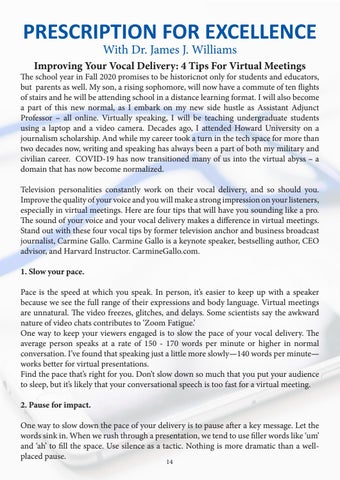PRESCRIPTION FOR EXCELLENCE With Dr. James J. Williams
Improving Your Vocal Delivery: 4 Tips For Virtual Meetings
The school year in Fall 2020 promises to be historicnot only for students and educators, but parents as well. My son, a rising sophomore, will now have a commute of ten flights of stairs and he will be attending school in a distance learning format. I will also become a part of this new normal, as I embark on my new side hustle as Assistant Adjunct Professor – all online. Virtually speaking, I will be teaching undergraduate students using a laptop and a video camera. Decades ago, I attended Howard University on a journalism scholarship. And while my career took a turn in the tech space for more than two decades now, writing and speaking has always been a part of both my military and civilian career. COVID-19 has now transitioned many of us into the virtual abyss – a domain that has now become normalized. Television personalities constantly work on their vocal delivery, and so should you. Improve the quality of your voice and you will make a strong impression on your listeners, especially in virtual meetings. Here are four tips that will have you sounding like a pro. The sound of your voice and your vocal delivery makes a difference in virtual meetings. Stand out with these four vocal tips by former television anchor and business broadcast journalist, Carmine Gallo. Carmine Gallo is a keynote speaker, bestselling author, CEO advisor, and Harvard Instructor. CarmineGallo.com. 1. Slow your pace. Pace is the speed at which you speak. In person, it’s easier to keep up with a speaker because we see the full range of their expressions and body language. Virtual meetings are unnatural. The video freezes, glitches, and delays. Some scientists say the awkward nature of video chats contributes to ‘Zoom Fatigue.’ One way to keep your viewers engaged is to slow the pace of your vocal delivery. The average person speaks at a rate of 150 - 170 words per minute or higher in normal conversation. I’ve found that speaking just a little more slowly—140 words per minute— works better for virtual presentations. Find the pace that’s right for you. Don’t slow down so much that you put your audience to sleep, but it’s likely that your conversational speech is too fast for a virtual meeting. 2. Pause for impact. One way to slow down the pace of your delivery is to pause after a key message. Let the words sink in. When we rush through a presentation, we tend to use filler words like ‘um’ and ‘ah’ to fill the space. Use silence as a tactic. Nothing is more dramatic than a wellplaced pause. 14

